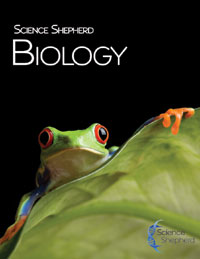As a homeschooling father, Dr. Scott Hardin realized that he and other parents were concerned about providing high-level science education to their children. He decided to create science courses for junior and senior high that would raise the bar yet still be suitable for students to work through independently.
Life Science, Fundamentals of Chemistry, and Fundamentals of Physics can be used with students in grades six through nine, and Biology is a high-school-level course that also prepares students to take the CLEP exam for college credit. I reviewed Life Science and Biology, but not Chemistry or Fundamentals of Physics.
These courses are more challenging than most others used by homeschoolers. While both Life Science and Biology cover most of the same topics as do other texts for the same audiences, the presentation requires a higher level of student attention. This might be due to the writing style. As an example, the following excerpt is from Life Science, p. 59.
As we know from the last chapter, all cells are bounded by a cell membrane that encloses the cell’s interior and protects its contents. Every cell contains smaller units, called organelles, which perform specific functions in the cell. The only organelles that prokaryotes have are ribosomes to make proteins. Ribosomes are not covered by a membrane. Eukaryotes have ribosomes and many other types of organelles. All eukaryotic organelles, except ribosomes, are covered with a membrane—a lipid bilayer just like the cell membrane. Prokaryotic and eukaryotic cells both have DNA. Prokaryotic DNA is contained in the cytoplasm in an area called the nucleoid. The DNA of eukaryotes is inside the nucleus.
In addition, pages are denser with print than in many other texts. Full-color illustrations are helpful, but these are accompanied by sometimes lengthy explanations in small fonts that also need to be read. Students who have excellent concentration and reading skills should be able to use these texts, but those weak in either area might have trouble.
Both textbooks present the material in a similar fashion. Each chapter begins with a chapter preview and a brief overview. Then each topic is taught as you would find in most textbooks. Each chapter concludes with a summary of key points, a vocabulary list with definitions, and a set of study questions for students to answer. For each text, there are a Test Booklet and an Answer Key & Parent Companion. The Answer Key & Parent Companion has answers to both study and test questions. It also has chapter outlines with key points summarized for each section. A helpful extra for parents who want to stay connected to what their students are learning is the “topic questions.” Parents can present the topic questions for each section within a chapter if they wish; there are quite a few of these questions for each chapter. Suggested answers are provided, so the parent need not actually read the material.
Life Science does not have a lab component, but Science Shepherd recommends the inexpensive Life Science Quest book for lab activities if you wish to make it a lab class.
For the Biology course, they have a complete Biology Lab Manual with twenty labs, including dissections. These were designed to be done at home although some equipment is needed—a microscope, slides, a dissection kit, and stains for creating slides, in addition to other items that can be purchased at a drug or grocery store. Science Shepherd has partnered with Rainbow Resource Center to provide a kit with all materials except the microscope and the Biology Lab Manual.
They have also produced Biology Lab Videos with complete demonstrations of all labs, including reproductions of slides viewed through the microscope. Students who watch the labs and complete the worksheets in the manual might still be able to obtain credit for a full lab course since the video labs cover the steps of each lab activity. Note that the lab videos combine video and narrated PowerPoint® presentations that vary depending on the nature of the lab. Dr. Hardin explains each step slowly and clearly so it is easy for students to follow along in the lab manual. Answers to lab activities are at the back of the lab manual.
Both Life Science and Biology also have an optional video course that can be used along with the coursebook. The video course for Life Science is over 20 hours, and that for Biology is over 40 hours and includes the previously mentioned Biology Lab Videos. Both the course and lab videos are available via streaming or on a DVD. Check the publisher’s website for bundle options that include the videos with the other course components.
Evolution
Since Dr. Hardin is a Christian, he wanted to point out problems with the theory of evolution, while still teaching students what they are expected to know about evolution. So he devotes one chapter in Life Science and three chapters in Biology to the topic. He presents both evolution and creationism as philosophies, but he ends up demonstrating that creationism is more plausible than evolution. Throughout the rest of both texts, the science is presented objectively without reference to either philosophy. This is in contrast to many texts used by Christian homeschoolers that integrate creationism throughout.
For more on the origins debate, Dr. Hardin has free resources that include three creation science lectures and The Genesis Worldview course with 13 video lessons. He also sells a book titled The Philosophy & History of Origins that can be used by high school students and adults.
Summary
These courses fit a unique niche in the homeschool market since they are designed for independent study, teach at a challenging level, deal with the evolution/creation question in a manner not offensive to creationists, and provide a lab component, all without requiring parental involvement beyond checking answers.









